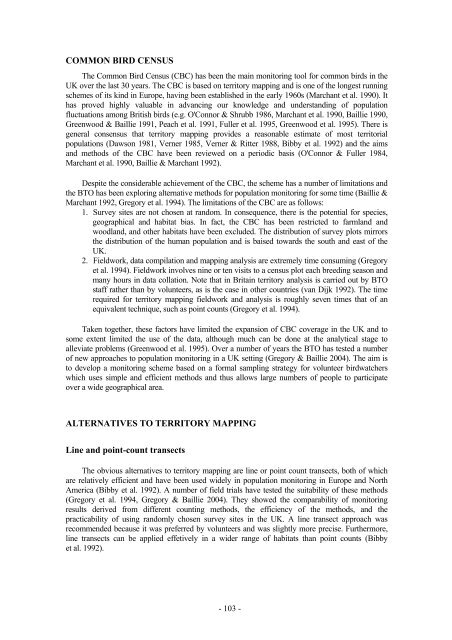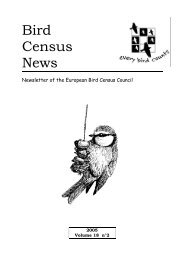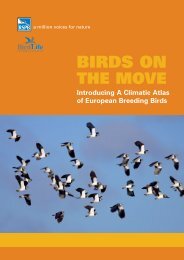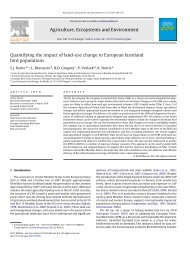monitoring breeding birds in the united kingdom - European Bird ...
monitoring breeding birds in the united kingdom - European Bird ...
monitoring breeding birds in the united kingdom - European Bird ...
You also want an ePaper? Increase the reach of your titles
YUMPU automatically turns print PDFs into web optimized ePapers that Google loves.
COMMON BIRD CENSUS<br />
The Common <strong>Bird</strong> Census (CBC) has been <strong>the</strong> ma<strong>in</strong> <strong>monitor<strong>in</strong>g</strong> tool for common <strong>birds</strong> <strong>in</strong> <strong>the</strong><br />
UK over <strong>the</strong> last 30 years. The CBC is based on territory mapp<strong>in</strong>g and is one of <strong>the</strong> longest runn<strong>in</strong>g<br />
schemes of its k<strong>in</strong>d <strong>in</strong> Europe, hav<strong>in</strong>g been established <strong>in</strong> <strong>the</strong> early 1960s (Marchant et al. 1990). It<br />
has proved highly valuable <strong>in</strong> advanc<strong>in</strong>g our knowledge and understand<strong>in</strong>g of population<br />
fluctuations among British <strong>birds</strong> (e.g. O'Connor & Shrubb 1986, Marchant et al. 1990, Baillie 1990,<br />
Greenwood & Baillie 1991, Peach et al. 1991, Fuller et al. 1995, Greenwood et al. 1995). There is<br />
general consensus that territory mapp<strong>in</strong>g provides a reasonable estimate of most territorial<br />
populations (Dawson 1981, Verner 1985, Verner & Ritter 1988, Bibby et al. 1992) and <strong>the</strong> aims<br />
and methods of <strong>the</strong> CBC have been reviewed on a periodic basis (O'Connor & Fuller 1984,<br />
Marchant et al. 1990, Baillie & Marchant 1992).<br />
Despite <strong>the</strong> considerable achievement of <strong>the</strong> CBC, <strong>the</strong> scheme has a number of limitations and<br />
<strong>the</strong> BTO has been explor<strong>in</strong>g alternative methods for population <strong>monitor<strong>in</strong>g</strong> for some time (Baillie &<br />
Marchant 1992, Gregory et al. 1994). The limitations of <strong>the</strong> CBC are as follows:<br />
1. Survey sites are not chosen at random. In consequence, <strong>the</strong>re is <strong>the</strong> potential for species,<br />
geographical and habitat bias. In fact, <strong>the</strong> CBC has been restricted to farmland and<br />
woodland, and o<strong>the</strong>r habitats have been excluded. The distribution of survey plots mirrors<br />
<strong>the</strong> distribution of <strong>the</strong> human population and is baised towards <strong>the</strong> south and east of <strong>the</strong><br />
UK.<br />
2. Fieldwork, data compilation and mapp<strong>in</strong>g analysis are extremely time consum<strong>in</strong>g (Gregory<br />
et al. 1994). Fieldwork <strong>in</strong>volves n<strong>in</strong>e or ten visits to a census plot each <strong>breed<strong>in</strong>g</strong> season and<br />
many hours <strong>in</strong> data collation. Note that <strong>in</strong> Brita<strong>in</strong> territory analysis is carried out by BTO<br />
staff ra<strong>the</strong>r than by volunteers, as is <strong>the</strong> case <strong>in</strong> o<strong>the</strong>r countries (van Dijk 1992). The time<br />
required for territory mapp<strong>in</strong>g fieldwork and analysis is roughly seven times that of an<br />
equivalent technique, such as po<strong>in</strong>t counts (Gregory et al. 1994).<br />
Taken toge<strong>the</strong>r, <strong>the</strong>se factors have limited <strong>the</strong> expansion of CBC coverage <strong>in</strong> <strong>the</strong> UK and to<br />
some extent limited <strong>the</strong> use of <strong>the</strong> data, although much can be done at <strong>the</strong> analytical stage to<br />
alleviate problems (Greenwood et al. 1995). Over a number of years <strong>the</strong> BTO has tested a number<br />
of new approaches to population <strong>monitor<strong>in</strong>g</strong> <strong>in</strong> a UK sett<strong>in</strong>g (Gregory & Baillie 2004). The aim is<br />
to develop a <strong>monitor<strong>in</strong>g</strong> scheme based on a formal sampl<strong>in</strong>g strategy for volunteer birdwatchers<br />
which uses simple and efficient methods and thus allows large numbers of people to participate<br />
over a wide geographical area.<br />
ALTERNATIVES TO TERRITORY MAPPING<br />
L<strong>in</strong>e and po<strong>in</strong>t-count transects<br />
The obvious alternatives to territory mapp<strong>in</strong>g are l<strong>in</strong>e or po<strong>in</strong>t count transects, both of which<br />
are relatively efficient and have been used widely <strong>in</strong> population <strong>monitor<strong>in</strong>g</strong> <strong>in</strong> Europe and North<br />
America (Bibby et al. 1992). A number of field trials have tested <strong>the</strong> suitability of <strong>the</strong>se methods<br />
(Gregory et al. 1994, Gregory & Baillie 2004). They showed <strong>the</strong> comparability of <strong>monitor<strong>in</strong>g</strong><br />
results derived from different count<strong>in</strong>g methods, <strong>the</strong> efficiency of <strong>the</strong> methods, and <strong>the</strong><br />
practicability of us<strong>in</strong>g randomly chosen survey sites <strong>in</strong> <strong>the</strong> UK. A l<strong>in</strong>e transect approach was<br />
recommended because it was preferred by volunteers and was slightly more precise. Fur<strong>the</strong>rmore,<br />
l<strong>in</strong>e transects can be applied effetively <strong>in</strong> a wider range of habitats than po<strong>in</strong>t counts (Bibby<br />
et al. 1992).<br />
- 103 -






